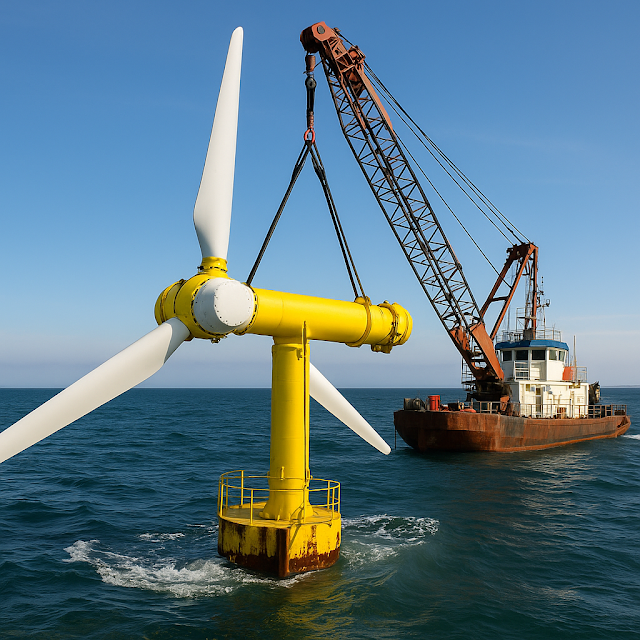1. How Tidal Energy Works
1.1 Tidal Mechanisms
Tidal energy systems operate based on two main principles:
-
Tidal Range (Potential Energy): The vertical difference in water levels between high tide and low tide.
-
Tidal Stream (Kinetic Energy): The horizontal movement of water during tides.
1.2 Types of Tidal Energy Systems
| Type | Description | Principle Used |
|---|---|---|
| Tidal Barrage | A dam-like structure captures high tide water and releases it through turbines. | Potential Energy |
| Tidal Stream Generators | Submerged turbines extract energy from moving water. | Kinetic Energy |
| Dynamic Tidal Power | Long dams perpendicular to coastlines create pressure differences. | Hybrid |
2. Technical Description and Equations
2.1 Energy from Tidal Range (Barrage)
The potential energy stored in a volume of water due to tidal range is calculated as:
Where:
-
= density of seawater (≈ 1025 kg/m³)
-
= gravitational acceleration (9.81 m/s²)
-
= surface area of basin (m²)
-
= tidal height (m)
Example Calculation
Suppose:
-
Area
-
Tidal range
If two cycles (high and low tide) occur daily, annual energy ≈ or 50.83 GWh/year.
2.2 Power from Tidal Stream Turbines
Figure 1: Tidal Stream Energy System Showing Turbine Components and Power Extraction Equation
The power from a tidal stream turbine is given by:
Where:
-
= water velocity (m/s)
-
= power coefficient (efficiency, typically 0.3–0.5)
-
= swept area of turbine blades (m²)
Example Calculation
Assume:
-
Turbine diameter = 10 m →
-
,
3. Benefits of Tidal Energy
| Benefit | Details |
|---|---|
| Predictability | Tides follow celestial cycles and are highly predictable decades in advance. |
| Low Visual Impact | Submerged turbines remain out of sight. |
| Zero Emissions | No CO₂, NOₓ, or SO₂ emissions during operation. |
| High Energy Density | Seawater is ~800 times denser than air → more energy per swept volume. |
| Longevity | Systems can operate for 30–100 years with low maintenance. |
4. Real-World Applications and Projects
4.1 La Rance Tidal Power Plant, France
-
Type: Tidal Barrage
-
Capacity: 240 MW
-
In Operation Since: 1966
-
Annual Generation: ~500 GWh
4.2 MeyGen Tidal Array, Scotland
-
Type: Tidal Stream
-
Capacity: 398 MW (planned)
-
Deployed Capacity (2025): ~86 MW
-
Significance: Largest tidal stream array in the world.
4.3 Sihwa Lake Tidal Power Station, South Korea
-
Type: Tidal Barrage
-
Capacity: 254 MW
-
Annual Output: ~550 GWh
5. Challenges and Considerations
| Challenge | Description |
|---|---|
| High Capital Cost | Infrastructure like barrages and subsea cables is expensive. |
| Environmental Impact | Barrages can disrupt sediment flow and fish migration. |
| Limited Sites | Only specific coastal locations have suitable tidal ranges or speeds. |
| Grid Integration | Requires smart grid tech to manage intermittent generation. |
6. Frequently Asked Questions (FAQs)
Q1: Is tidal energy more reliable than solar or wind?
Yes. Tidal energy is highly predictable due to the regular gravitational cycles of the moon and sun, unlike solar and wind which vary daily and seasonally.
Q2: What is the difference between tidal and wave energy?
Tidal energy is driven by the gravitational interaction of the Earth-Moon system, while wave energy is generated by the wind's action on the ocean surface.
Q3: Can tidal energy power a city?
Potentially, yes. Large-scale tidal power stations like La Rance generate enough electricity to power over 100,000 homes.
Q4: Is tidal energy economically viable?
Costs are high upfront, but long operational life and predictable output can result in competitive Levelized Cost of Energy (LCOE) over decades.
Q5: What is the environmental impact of tidal power?
Barrage systems may impact estuarine ecosystems and fish migration, but tidal stream systems are less intrusive if designed properly.
7. Conclusion
Tidal energy stands out as a promising and underutilized form of renewable energy. With advancements in turbine efficiency, underwater cabling, and environmental mitigation, tidal energy could become a cornerstone of future clean energy grids — particularly for coastal nations with strong tidal resources.


